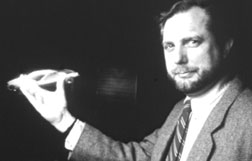Dedication
Introduction
Dan Ariely
Walter Bender
Steve Benton
Bruce Blumberg
V. Michael Bove, Jr.
Cynthia Breazeal
Ike Chuang
Chris Csikszentmihályi
Glorianna Davenport
Judith Donath
Neil Gershenfeld
Hiroshi Ishii
Joe Jacobson
Andy Lippman
Tod Machover
John Maeda
Scott Manalis
Marvin Minsky
William J. Mitchell
Seymour Papert
Joe Paradiso
Sandy Pentland
Rosalind Picard
Mitchel Resnick
Deb Roy
Chris Schmandt
Ted Selker
Barry Vercoe
Steve Benton
At the risk of overusing the word "passion"—which seems destined for the same unhappy fate as "creativity"—I have a passion for helping cocksure ignorance evolve into thoughtful uncertainty, for tickling my 3-D funnybone, and for being in the room when exciting new things are being created.
 Holography has two meanings in our world: the specific Nobel Prize-winning interference-and-diffraction discovery by Dennis Gabor, and the more general "psychologically ultimate 3-D imaging of the future," as envisioned in movies and TV. Our job is to move the second holography toward reality without violating more than one law of physics at a time. This is to say that while we haven't quite produced Princess Leia (which requires turning photons around in mid-air), we have done some other interesting things considered practically impossible just a few years ago. For example, we have created, transmitted, and displayed electronic 3-D holograms. Beyond that, we have superimposed the holographic display with a "touch and feel" haptic display, and developed software that allows us to literally touch, probe, and even carve a holographic image, finally bringing interactivity to digital technology.
Holography has two meanings in our world: the specific Nobel Prize-winning interference-and-diffraction discovery by Dennis Gabor, and the more general "psychologically ultimate 3-D imaging of the future," as envisioned in movies and TV. Our job is to move the second holography toward reality without violating more than one law of physics at a time. This is to say that while we haven't quite produced Princess Leia (which requires turning photons around in mid-air), we have done some other interesting things considered practically impossible just a few years ago. For example, we have created, transmitted, and displayed electronic 3-D holograms. Beyond that, we have superimposed the holographic display with a "touch and feel" haptic display, and developed software that allows us to literally touch, probe, and even carve a holographic image, finally bringing interactivity to digital technology.
But our world is an impatient world, so we are also working on holographically inspired 3-D systems that require no special glasses for viewing. As the viewer moves from side to side, new perspective views are very rapidly computed and presented, so that the image's appearance approaches that of a hologram, with "look around" and "look over and under."
Will our inventions ever present a truly satisfying "window view upon reality"—whether from a digital source or a remote location? It's still too early to know. But our world's appetite for the realism and engagement that truly high-quality 3-D can offer won't be satisfied until we finish the job.
Favorite childhood toy: definitely the old mechanical construction sets!